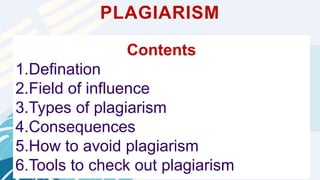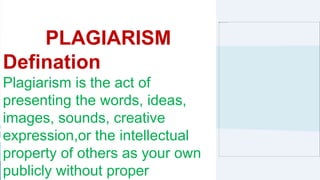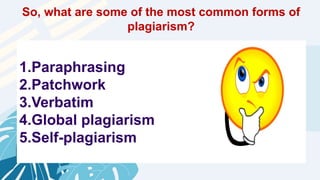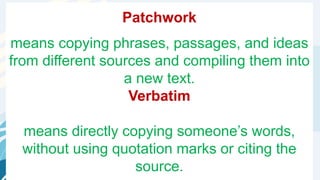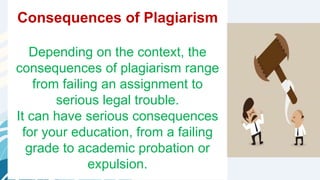Plagiarisma 2020-EE-05.pptx
- 1. —— Presentation Subject: Technical Writing & Essential Communicational Skills. Presented by: M Faisal Sheraz Khan 2020EE05 M Usman 2020EE04 M Naeem
- 2. PLAGIARISM Contents 1.Defination 2.Field of influence 3.Types of plagiarism 4.Consequences 5.How to avoid plagiarism 6.Tools to check out plagiarism
- 3. PLAGIARISM Defination Plagiarism is the act of presenting the words, ideas, images, sounds, creative expression,or the intellectual property of others as your own publicly without proper
- 4. In Academia • Within academia, plagiarism by students, professors, or researchers is considered academic dishonesty or academic fraud, and offenders are subject to academic censure, up to and including expulsion. Some institutions use plagiarism detection software to uncover potential plagiarism and to deter students from plagiarizing.
- 5. So, what are some of the most common forms of plagiarism? 1.Paraphrasing 2.Patchwork 3.Verbatim 4.Global plagiarism 5.Self-plagiarism
- 7. Patchwork means copying phrases, passages, and ideas from different sources and compiling them into a new text. Verbatim means directly copying someone’s words, without using quotation marks or citing the source.
- 8. 1.Quoting someone's words from the Internet, a printed article, or an interview, without acknowledging the author. 2.Copying part of the content of a work into one's own paper without citing the source. 3.Copying or buying a paper and handing it in as one's own. 4.Falsely creating a citation that doesn't exist. 5.Failing to credit and cite someone else's thoughts or ideas when paraphrasing. 6.Paraphrasing in a way that relies too heavily on another's language or syntax. Examples Of Plagiarism
- 9. PLAGIARISM V COPYRIGHT INFRINGEMENT 1. Copyright infringement includes the unauthorized or unlicensed copying of a work subject to copyright. 2. ©️ Copyright violation occurs only when a specific fixed expression (e.g., sequence of words, use of an image) is copied. 1. Plagiarism is using someone else's work or ideas without giving proper credit.- you are presenting the idea or thought as your own. 2. Plagiarism applies when ideas are copied.
- 10. PLAGIARISM V COPYRIGHT INFRINGEMENT 1. Plagiarism applies when ideas are copied; copyright violation occurs only when a specific fixed expression (e.g., sequence of words, use of an image) is copied. 2. Avoiding plagiarism is about properly apportioning intellectual credit; copyright is about maintaining revenue streams
- 11. Consequences of Plagiarism Depending on the context, the consequences of plagiarism range from failing an assignment to serious legal trouble. It can have serious consequences for your education, from a failing grade to academic probation or expulsion.
- 12. Avoiding Plagiarism The most surefire way to avoid plagiarism is to always Cite your Sources.You want to use an idea or information from a source, but the original phrasing isn’t important, Paraphrase It.When you want to include an exact phrase, sentence, or passage from a source, Quote It.
- 13. Tools for plagiarism check 1.Dupli Checker 2.Copyleaks 3.Plagiarisma 4.Plagiarism Checker 5.Plagium 6.PaperRater
- 14. Thank you

